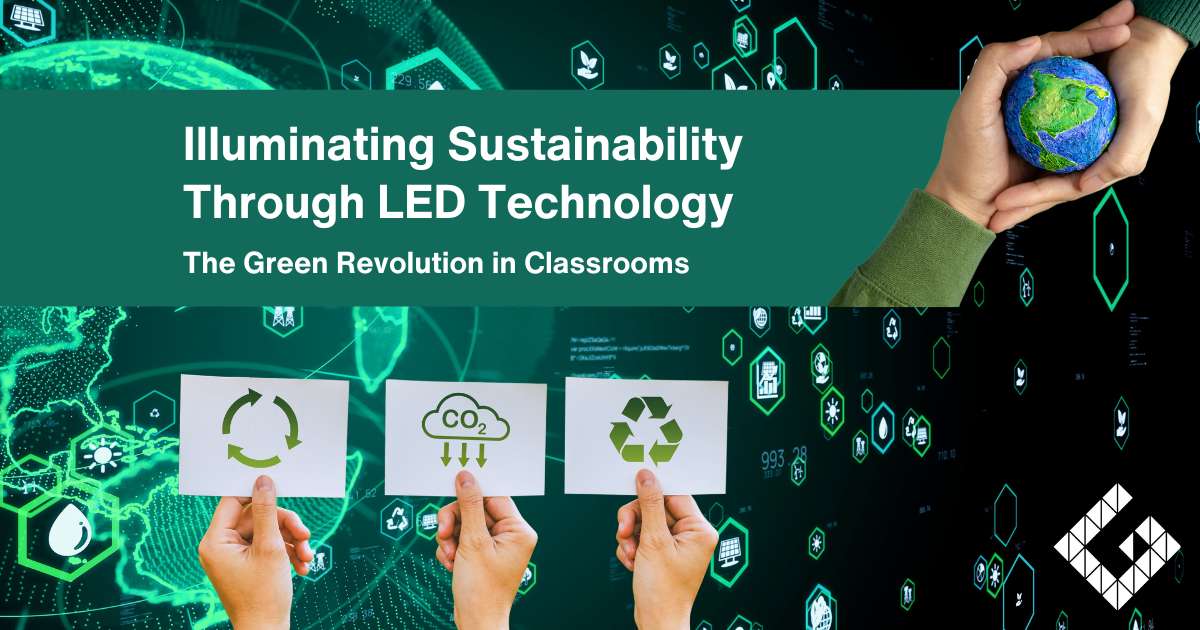Illuminating Sustainability Through LED Technology: The Green Revolution in Classrooms

Illuminating Sustainability Through LED Technology: The Green Revolution in Classrooms. In the educational context, where resource optimisation is of paramount importance, the implementation of smart energy management becomes a strategic choice. Certain innovations shine brighter than the rest. One such luminary is Light Emitting Diode (LED) technology, long celebrated for its superior energy efficiency when compared to traditional lighting sources. The inherent qualities of LED technology, such as high colour range, definition, and brightness, redefine the user experience. When students and educators interact with screens for extended periods, the reduction in eye strain, fatigue, and headaches through the flicker-free imagery is a welcome benefit. The colour reproduction capability is also particularly crucial, as conveying information with visual impact is essential to engage students. With the ability to display more than fifteen million colours, LED screens create an immersive visual experience.
But beyond the user-centric benefits, the sustainability advantages of LED are as diverse as they are impactful.
To empower educators to get the most out of their technology investments with a keen eye on the power grid, Genee developed the GEMS Series (consisting of the Opal, Sapphire, Emerald, and Ruby ranges) with LED technology.
In a world where every decision carries environmental implications, the GEMS Series stands as a beacon, not just in terms of visual brilliance and financial prudence but also in championing sustainable manufacturing practices. Incorporating LED into our screens is a tangible commitment to a greener and more sustainable future.
Shaping a Greener Fiscal Landscape
In an educational context where fiscal responsibility is a constant consideration, the economic advantages of LEDs are profound. Unlike traditional lighting sources, LEDs radiate light in a specific direction, eliminating the need for reflectors or diffusers. This directional emission translates into a substantial reduction in power consumption for classroom screens.
LED not only alleviates financial burdens but also extends the operational lifespan of screens, reducing the frequency of replacements. This means less electronic waste, a pressing concern in today’s world.
Eco-friendly Components and Lower Heat Generation
The environmental impact of technology is not limited to its usage but extends to the manufacturing process. LED screens, in their evolution, have embraced eco-friendly practices, employing cleaner production techniques, reducing water usage, and implementing robust waste management systems. Additionally, LED screens generate less heat compared to conventional displays, fostering not only operational efficiency but also reducing the energy demand for cooling systems in indoor environments. This commitment to eco-friendly manufacturing aligns with the broader goal of reducing the carbon footprint associated with technology.
Smart Energy Management: Illuminating the Path to Sustainable Learning Spaces
LED screens are equipped with light sensors and automated dimming controls. This not only ensures energy-efficient operation but also exemplifies adaptive technology. These features adjust screen brightness based on ambient light conditions and user activity, optimising energy usage, reducing the overall environmental impact associated with electricity consumption. This adaptability, responding to changes in the environment in real-time, contributes to creating a sustainable and eco-friendly learning space.
Conclusion: A Holistic Approach to Technology
The synergy between energy efficiency, economic prudence, and environmental responsibility is a testament to a conscious choice towards responsible resource management. The choice to adopt LED technology, especially through solutions like the GEMS Series, embodies a holistic approach to a school’s digital transformation journey. Institutions not only benefit from reduced operational costs, and not only invest in state-of-the-art technology, but actively champion environmental conservation efforts. The profound implications of such choices transcend the confines of the classroom, creating a ripple effect that resonates far and wide in the broader landscape of education.
To learn more about the GEMS Series, and how Genee can help empower your institution in its digital transformation journey, please click here.
